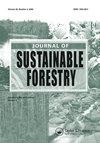Leaf Litter Decomposition and Nutrient Release Dynamics of Flemingia semialata Roxb. - A Potential Woody Perennial Species for Mountain Agroforestry
IF 1.8
4区 农林科学
Q3 FORESTRY
引用次数: 3
Abstract
ABSTRACT Leaf litter decomposition and nutrient release dynamics of Flemingia semialata Roxb. were studied from May 2016 to April 2017 using the litter bag technique. The study on litter dynamics is needed to assess the nutrient release pattern before introduction in degraded or marginal lands or agroforestry systems for soil nutrient management practices in hilly northeast states of India. The initial N concentration, lignin content, and lignin/N ratio of leaf litter had significant positive correlations with decay coefficients. The annual decay rate constant (k) for dry matter was 0.01 day−1 (3.65 year−1) with t50 and t99 values of 96.43 and 695.73 days, respectively, indicating faster leaf litter decomposition. Initial C (51%), N (2.38%), and low lignin concentrations with low C/N (21.53) and lignin/N (4.05) ratios could be important factors in faster mass loss from the litter samples. The P mineralization k P (2.19) rate was higher than k N (0.73), indicating the slower release rate of N. The weight loss during decomposition was positively correlated with rainfall (r = 0.42) and temperature (r = 0.39). The study suggests that F. semialata leaf litter could be useful for regulating soil nutrient pool through faster litter turnover and can therefore be exploited as plantation and/or agroforestry species for soil and water conservation in degraded slopy terrain of the region.半宽叶明的落叶分解及养分释放动态一种潜在的山地农林木本多年生植物
半宽叶明的落叶分解和养分释放动态。于2016年5月至2017年4月使用垃圾袋技术进行了研究。在印度东北部丘陵州引入退化或边缘土地或农林业系统进行土壤养分管理实践之前,需要对枯枝落叶动态进行研究,以评估养分释放模式。枯枝落叶的初始氮浓度、木质素含量和木质素/N比与腐朽系数呈显著正相关。干物质的年衰减率常数(k)为0.01天−1(3.65年−1),t50和t99值分别为96.43和695.73天,表明落叶分解更快。初始C(51%)、N(2.38%)和具有低C/N(21.53)和木质素/N(4.05)比率的低木质素浓度可能是枯枝落叶样品质量损失较快的重要因素。磷矿化钾磷(2.19)速率高于钾氮(0.73),表明氮的释放速率较慢。分解过程中的重量损失与降雨量(r=0.42)和温度(r=0.39)呈正相关。研究表明,半阔叶枯落物可以通过更快的枯落物周转来调节土壤养分库,因此可以作为种植园和/或农林业物种在该地区退化的坡面上进行水土保持。
本文章由计算机程序翻译,如有差异,请以英文原文为准。
求助全文
约1分钟内获得全文
求助全文
来源期刊

Journal of Sustainable Forestry
Social Sciences-Geography, Planning and Development
CiteScore
3.90
自引率
12.50%
发文量
42
期刊介绍:
Journal of Sustainable Forestry publishes peer-reviewed, original research on forest science. While the emphasis is on sustainable use of forest products and services, the journal covers a wide range of topics from the underlying biology and ecology of forests to the social, economic and policy aspects of forestry. Short communications and review papers that provide a clear theoretical, conceptual or methodological contribution to the existing literature are also included in the journal.
Common topics covered in the Journal of Sustainable Forestry include:
• Ecology, management, recreation, restoration and silvicultural systems of all forest types, including urban forests
• All aspects of forest biology, including ecophysiology, entomology, pathology, genetics, tree breeding, and biotechnology
• Wood properties, forest biomass, bioenergy, and carbon sequestration
• Simulation modeling, inventory, quantitative methods, and remote sensing
• Environmental pollution, fire and climate change impacts, and adaptation and mitigation in forests
• Forest engineering, economics, human dimensions, natural resource policy, and planning
Journal of Sustainable Forestry provides an international forum for dialogue between research scientists, forest managers, economists and policy and decision makers who share the common vision of the sustainable use of natural resources.
 求助内容:
求助内容: 应助结果提醒方式:
应助结果提醒方式:


